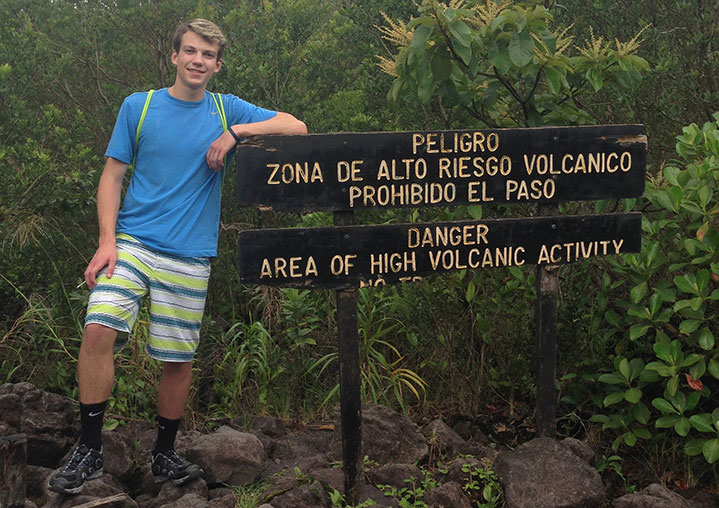When 34 high school students landed in June at Juan Santamaría International Airport in the Costa Rican capital of San Jose, the West Michigan teenagers entered a world of Spanish, from the airport signage and customs agents to dates written in unfamiliar ways.
The students – headed into the 11th grade and fluent in Spanish 3 from a traditional classroom setting – pledged to absorb all that Costa Rica offered during the 10-day international adventure, taken through EF Educational Tours.
They leaped at the opportunity to interact with the locals, seeking cross-cultural interactions everywhere. Right away 11th-grader Jaden Gorsch and his travel-mates visited a supermercado and realized everything was in Spanish, metrics and colones, the Costa Rican currency.
“The bills, the colones are different so we didn’t know the money, the (paper) bills themselves,” Jaden said. “Like one dollar is worth about 500 colones. The (paper) bills started at 1,000 colones –- which is almost $2. That part was more a struggle than anything.”
Good, very good, said Spanish teacher Holly Martin.
“It was just fun seeing their faces at that first grocery store and knowing that they would have to figure this out,” Martin said. “We wanted the kids to have an international experience in all ways, big and small.”

Overcoming the Hesitancy
While navigating the rugged, rain-forested country, the Grandville High linguists honed their soft skills – speaking in Spanish with the farmers market vendors, cashiers, waiters, hotel clerks and beachcombers.
“The accents were sometimes harder to understand and they used some words that we didn’t know,” said 11th-grader Abigail Bilisko. “We definitely picked up a lot of vocabulary, different words and the quickness that comes from having a real conversation.”
Communicating primarily in Spanish began to work a little magic in their brains. All of a sudden, they weren’t translating the Spanish into English –- they were beginning to think in Spanish.
“In the beginning, they were certainly speaking Spanish in a survival like way,” Martin said. “But as they gained their confidence, they began to really talk to people.”
Asthey traversed the country, junior Rania Bush liked reading every business sign, menu, street name and picking up new vocabulary. “It was an opportunity to explore, to meet more people, to talk to everyone that we met,” Rania said.
As Martin knows from her many travels throughout Spain, students must experience the culture and environment to truly understand a language that is not their own. All six Grandville High Spanish teachers are bent on showing students the value of learning Spanish, and work diligently to help them build real-life skills rather than rote memorization. A visit to Spain’s on the calendar for 2019.
“We all left raving about how kind, nice and friendly everyone is there,” Martin said. “They literally say ‘pura vida’ for hello, good day, goodbye, good luck, and that’s really their way of life — to live life to the fullest.”

Best School Field Trips Ever
To that end, the Grandville group of 45, including 34 students, Spanish teachers and parent chaperones, was constantly on the move: poking around the Santa Elena Cloud Forest; tasting cocoa pods on a chocolate tour; zooming along the highest, tallest zipline; hiking to La Fortuna waterfall, kayaking on Lake Arenal; and whitewater rafting on the Sarapiquí River.
“Costa Rica is ranked the happiest, greenest and I think the most environmentally conscious country in the world,” said Reece Morey, who has also vacationed in Mexico. “I really liked all the nature, the environmental preservation stuff, that was just all cool.”
During a night tour in Monteverde’s Cloud Forest, the delegation spotted venomous snakes, two-toed sloth, macaw parrots and large, hairy and poisonous tarantulas. They weren’t too fazed to see a scorpion in the shower, geckos in the room, and howler monkeys angling for the food right in your hand.
“We never stopped moving,” said Carolyn Peterson, who has also holidayed in Mexico, Belize and Honduras. “We wanted to experience everything so we got around.”
To further appreciate the life and leisure of Costa Rica, their EF tour guide arranged a dance lesson for the students to learn the cumbia, salsa and merengue. They couldn’t wait to hit the dance floor; “We loved the nightlife and the dancing,” Rania said.

Live Like a Local
The students quickly ascertained that they would need to supplement their daily diet of rice and beans with fresh tropical finds from the local farmers markets, called “fruterias.” They relished tasting the indigenous fruits and produce at their lodgings and supermercado.
“There were so many fruits and that we had never seen before,” said Carolyn, who often speaks Spanish while lifeguarding at a city pool located in a Hispanic neighborhood.
“We tried everything, like grapes the size of golf balls, guayaba — almost like guava and granadilla sort of a passion fruit with gray seeds and an inside that looked like snot. It didn’t look good, but it was so good.”
Martin hoped the students would appreciate the country’s diversity, strengthen their Spanish, glimpse real life there, but also internalize that Americans aren’t so different.
“Learning Spanish just expands your world, connects you with all Americans and millions of other people, so it’s not just us and them but ‘we together,'” Martin said.
Her Spanish students heard her loud and clear. Said junior Jack Miller, “I felt so comfortable there. The fruit seemed fresher and tasted so much better. The rainforest, the birds, everything felt more accessible.
“Itwas more of an experience, and less the kinds of things that come with a vacation.”
CONNECT










